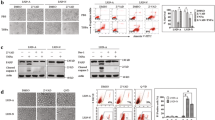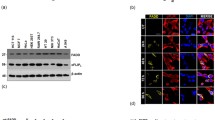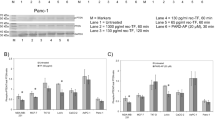Abstract
There is now circumstantial evidence that tissue factor pathway inhibitor (TFPI) is not only a major anticoagulant, but also has proapoptotic properties. The current study was designed to address the role of TFPI on signalling pathways and apoptosis. The non-TFPI expressing cell line CHO-K1 was stably transfected with pcDNA3.1/V5-His-TOPO-TFPI and control cells were established by transfecting the CHO-K1 cells with pcDNA3.1/V5-His-TOPO. Sodium butyrate (NaBut) has been shown to induce the expression of recombinant proteins. Here we have used NaBut to increase the expression of TFPI as assessed by qRT-PCR and ELISA. Compared to the control cells, TFPI induced apoptosis in a concentration dependent manner as measured by a cell death detection assay. Independent of caspase-3 activation an increased cleavage of PARP was detected in the TFPI expressing cells. This was accompanied by downregulation of Bcl-XL, elevated levels of Bax, and increased translocation of the apoptosis initiating factor. Increased DNA binding activity of NF-κB was revealed by electrophoretic mobility shift assay when the TFPI level was elevated by NaBut together with an increased translocation of the NF-κB subunit p65. The results indicate that TFPI affected the apoptotic activity through a process independent of caspase-3, and was also able to increase the activation of the NF- κB pathway.




Similar content being viewed by others
References
Sandset PM, Warn-Cramer BJ, Rao LV, Maki SL, Rapaport SI (1991) Depletion of extrinsic pathway inhibitor (EPI) sensitizes rabbits to disseminated intravascular coagulation induced with tissue factor: evidence supporting a physiologic role for EPI as a natural anticoagulant. Proc Natl Acad Sci USA 88:708–712
Girard TJ, Warren LA, Novotny WF, Likert KM, Brown SG, Miletich JP, Broze GJ Jr (1989) Functional significance of the Kunitz-type inhibitory domains of lipoprotein-associated coagulation inhibitor. Nature 338:518–520
Kurer MA (2007) Protein and mRNA expression of tissue factor pathway inhibitor-1 (TFPI-1) in breast, pancreatic and colorectal cancer cells. Mol Biol Rep 34:221–224
Lindahl AK, Sandset PM, Abildgaard U, Andersson TR, Harbitz TB (1989) High plasma levels of extrinsic pathway inhibitor and low levels of other coagulation inhibitors in advanced cancer. Acta Chir Scand 155:389–393
Iversen N, Lindahl AK, Abildgaard U (1998) Elevated TFPI in malignant disease: relation to cancer type and hypercoagulation. Br J Haematol 102:889–895
Hembrough TA, Swartz GM, Papathanassiu A, Vlasuk GP, Rote WE, Green SJ, Pribluda VS (2003) Tissue factor/factor VIIa inhibitors block angiogenesis and tumor growth through a nonhemostatic mechanism. Cancer Res 63:2997–3000
Dong X, Song L, Zhu D, Zhang H, Liu L, Leng X (2011) Tissue factor pathway inhibitor suppresses the growth of human vascular smooth muscle cells through regulating cell cycle. Mol Biol Rep 38:4771–4776
Fu Y, Zhang Z, Zhang G, Liu Y, Cao Y, Yu J, Hu J, Yin X (2008) Adenovirus-mediated gene transfer of tissue factor pathway inhibitor induces apoptosis in vascular smooth muscle cells. Apoptosis 13:634–640
Dong X, Song LP, Zhu DW, Zhang HL, Liu LX, Leng XG (2011) Impact of the tissue factor pathway inhibitor gene on apoptosis in human vascular smooth muscle cells. Genet Mol Biol 34:25–30
Stavik B, Skretting G, Sletten M, Sandset PM, Iversen N (2010) Overexpression of both TFPIalpha and TFPIbeta induces apoptosis and expression of genes involved in the death receptor pathway in breast cancer cells. Mol Carcinog 49:951–963
Stavik B, Skretting G, Aasheim HC, Tinholt M, Zernichow L, Sletten M, Sandset PM, Iversen N (2011) Downregulation of TFPI in breast cancer cells induces tyrosine phosphorylation signaling and increases metastatic growth by stimulating cell motility. BMC Cancer 11:357
Karin M, Lin A (2002) NF-kappaB at the crossroads of life and death. Nat Immunol 3:221–227
Graham B, Gibson SB (2005) The two faces of NFkappaB in cell survival responses. Cell Cycle 4:1342–1345
Chen Y, Wang J, Yao Y, Yuan W, Kong M, Lin Y, Geng D, Nie R (2009) CRP regulates the expression and activity of tissue factor as well as tissue factor pathway inhibitor via NF-kappaB and ERK 1/2 MAPK pathway. FEBS Lett 583:2811–2818
Jin H, Qiu WB, Mei YF, Wang DM, Li YG, Tan XR (2009) Testosterone alleviates tumor necrosis factor-alpha-mediated tissue factor pathway inhibitor downregulation via suppression of nuclear factor-kappa B in endothelial cells. Asian J Androl 11:266–271
Pajak B, Gajkowska B, Orzechowski A (2009) Sodium butyrate sensitizes human colon adenocarcinoma COLO 205 cells to both intrinsic and TNF-alpha-dependent extrinsic apoptosis. Apoptosis 14:203–217
Reuter S, Eifes S, Dicato M, Aggarwal BB, Diederich M (2008) Modulation of anti-apoptotic and survival pathways by curcumin as a strategy to induce apoptosis in cancer cells. Biochem Pharmacol 76:1340–1351
Barkett M, Gilmore TD (1999) Control of apoptosis by Rel/NF-kappaB transcription factors. Oncogene 18:6910–6924
Lauder A, Castellanos A, Weston K (2001) c-Myb transcription is activated by protein kinase B (PKB) following interleukin 2 stimulation of Tcells and is required for PKB-mediated protection from apoptosis. Mol Cell Biol 21:5797–5805
Cummings JH (1981) Short chain fatty acids in the human colon. Gut 22:763–779
Heerdt BG, Houston MA, Augenlicht LH (1994) Potentiation by specific short-chain fatty acids of differentiation and apoptosis in human colonic carcinoma cell lines. Cancer Res 54:3288–3293
Singh B, Halestrap AP, Paraskeva C (1997) Butyrate can act as a stimulator of growth or inducer of apoptosis in human colonic epithelial cell lines depending on the presence of alternative energy sources. Carcinogenesis 18:1265–1270
Barnard JA, Warwick G (1993) Butyrate rapidly induces growth inhibition and differentiation in HT-29 cells. Cell Growth Differ 4:495–501
Jiang Z, Sharfstein ST (2008) Sodium butyrate stimulates monoclonal antibody over-expression in CHO cells by improving gene accessibility. Biotechnol Bioeng 100:189–194
Place RF, Noonan EJ, Giardina C (2005) HDAC inhibition prevents NF-kappa B activation by suppressing proteasome activity: down-regulation of proteasome subunit expression stabilizes I kappa B alpha. Biochem Pharmacol 70:394–406
Rodrigues GH, Arthuso FS, Capone MV, de Oliveira TL, Bartolini P, Soares CR (2010) Enhancement of human prolactin synthesis by sodium butyrate addition to serum-free CHO cell culture. J Biomed Biotechnol 2010:405872
Skretting G, Lien T, Sandset PM, Iversen N (2009) Expression of the V264M TFPI mutant in endothelial cell cultures may involve mRNA stability. Thromb Res 123:851–855
Dahm A, Van Hylckama Vlieg A, Bendz B, Rosendaal F, Bertina RM, Sandset PM (2003) Low levels of tissue factor pathway inhibitor (TFPI) increase the risk of venous thrombosis. Blood 101:4387–4392
Yu SW, Andrabi SA, Wang H, Kim NS, Poirier GG, Dawson TM, Dawson VL (2006) Apoptosis-inducing factor mediates poly(ADP-ribose) (PAR) polymer-induced cell death. Proc Natl Acad Sci USA 103:18314–18319
Pastorino JG, Chen ST, Tafani M, Snyder JW, Farber JL (1998) The overexpression of Bax produces cell death upon induction of the mitochondrial permeability transition. J Biol Chem 273(13):7770–7775
Lin YF, Zhang N, Guo HS, Kong DS, Jiang T, Liang W, Zhao ZH, Tang QQ, Ma D (2007) Recombinant tissue factor pathway inhibitor induces apoptosis in cultured rat mesangial cells via its Kunitz-3 domain and C-terminal through inhibiting PI3-kinase/Akt pathway. Apoptosis 12:2163–2173
Inan MS, Rasoulpour RJ, Yin L, Hubbard AK, Rosenberg DW, Giardina C (2000) The luminal short-chain fatty acid butyrate modulates NF-kappaB activity in a human colonic epithelial cell line. Gastroenterology 118:724–734
Vlahos CJ, Matter WF, Hui KY, Brown RF (1994) A specific inhibitor of phosphatidylinositol 3-kinase, 2-(4-morpholinyl)-8-phenyl-4H-1-benzopyran-4-one (LY294002). J Biol Chem 269:5241–5248
Acknowledgments
The authors are grateful for the technical assistance of Erle Solheim. The study was financially supported by Grants from the Norwegian South-Eastern Health Authority.
Author information
Authors and Affiliations
Corresponding author
Rights and permissions
About this article
Cite this article
Skretting, G., Iversen, N., Myklebust, C.F. et al. Overexpression of tissue factor pathway inhibitor in CHO-K1 cells results in increased activation of NF-κB and apoptosis mediated by a caspase-3 independent pathway. Mol Biol Rep 39, 10089–10096 (2012). https://doi.org/10.1007/s11033-012-1882-7
Received:
Accepted:
Published:
Issue Date:
DOI: https://doi.org/10.1007/s11033-012-1882-7




